Introduction
It is known that humans have been using herbs and spices since 5000 BC [1,2]. These herbs and spices are being added to various foods [3]. In particular, it is mainly added to instant food and consumed [2,3]. Among them, ginger (Zingiber oficinale Rosc.) such as a powerful spice, is used not only for cooking but also for medical purposes worldwide [1–3].
In general, it was also known that ginger could contain up to 400 different ingredients [4,5]. Ginger included diverse ingredients such as water of 9.0%–12.0%, carbohydrates of 60.0%–70.0%, crude fiber of 3.0%–8.0%, protein of 9.0%, fatty oil of 3.0%–6.0%, volatile oil of 2.0%–3.0%, ash of 8.0%, and so on [5,6].
Nevertheless, according to the results of various studies on ginger so far, it has been found that the main pharmacological effects of ginger were mostly due to its phenol and terpene ingredients [4–6]. Among them, the phenolic ingredients derived from ginger contained gingerols, paradols, shogaols, zingerone, and so on, and also the terpene ingredients derived from ginger contained bisabolene, borneol, cineole, curcumene, geranial, farnesene, limonene, linalool, sesquiphellandrene, zingiberene, and so on [4–6]. Especially, it has been found that terpenes extracted from ginger could have many pharmacological effects, for example, anti-cancer, anti-bacterial, anti-diabetic, anti-hyperalgesic, anti-inflammatory, anti-oxidant, anti-viral, gastrointestinal, neuroprotective and so on [5,6].
Also, ginger included other shogaol- and gingerol-related ingredietns, for example, 1-dehydrogingerdione, diarylheptanoids, gingerdiols, 6-gingerdione, 10-gingerdione, and so on [4–6].
Gingerol had been found to be the main spicy ingredient in fresh ginger. In addition, gingerol was found to have various effects, for example, anti-angiogenic, anti-bacterial, anti-cancer activity, anti-emetic, anti-fungal, anti-hyperlipidemic, anti-inflammatory, anti-metastatic, anti-oxidant, neuroprotective, and so on [4–6].
Next, a common route for conversion of 6-gingerol to 6-shogaol was when ginger was dehydrated by drying or cooking [5,7]. It was found that the 6-shogaol produced at this time was very stable and exhibited a very strong pharmacological characteristics than 6-gingerol [5,6]. In addition, it was found that 6-paradol could be compounded through biotransformation of microorganisms by reducing the double bond of shogaol in 6-shogaol [5,6]. It was widely known that shogaol had a variety of effects, including anti-cancer, anti-emetic, anti-inflammatory, anti-oxidant, cardioprotective, neuroprotective, and so on [5].
Zingerone was not found in fresh ginger [5,8]. However, it had been found that when ginger was dried, heated or roasted, it could be compounded from gingerol through reverse aldolization [8]. Zingerone had been reported to have a wide variety of effects, for example, anti-anxiety, anti-bacterial, anti-diabetic, anti-cancer, anti-diarrheal, anti-emetic, anti-hyperlipidemic, anti-inflammatory, anti-oxidant, anti-spasmodic, anti-thrombotic, radioprotective, and so on [8]. Fig. 1 showed various bioactive and immunomodulatory potential of ginger.
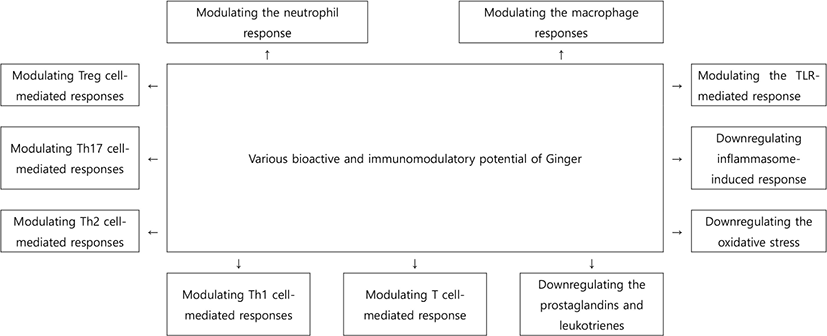
It is known that essential oils are mostly composed of volatile bioactive molecules isolated from various plant sources which were flowers, leaves, roots, seeds, stems, and so on [9,10]. Furthermore, essential oil could be an interesting alternative due to their beneficial properties in food matrices. In addition, in recent years, due to the various therapeutic outcome of plant essential oils, they have been extensively used for food preservation and food packaging, and also for keeping food quality and safety [11,12].
Hence, direct supplementation of commercially available dairy and non-dairy products with ginger oil containing various bioactive substances has been actively recommended in recent years. In other words, it is thought that many functional substances of ginger oil supplemented with various foods will be more activated, eventually improving human health and ameliorating the organoleptic quality assessment of products. But, studies on the organoleptic quality assessment after supplemented with ginger oil directly to various dairy products or non-dairy products are insufficient so far.
Consequently, the objective of this study is to estimate the organoleptic quality assessment supplemented with ginger oil of various concentrations to cow milk, yoghurt, Kefir, soy milk, oat milk, and almond milk respectively.
Materials and Methods
Ginger oil used in this study is approved as a food additive. 100% Live Natural Ginger Oil (30 mL) manufactured by Hermani General Trading LLC (UAE) was purchased.
Ginger oil was directly supplemented with cow milk, yoghurt, Kefir, soy milk, oat milk, and almond milk at various concentrations (supplemented with 0.5% increments from 0% up to 2%). All samples of cow milk, yoghurt, Kefir, soy milk, oat milk, and almond milk supplemented with ginger oil were stored at about 8°C until analysis. All samples were purchased from a mart located in Seoul, and a description of the samples used in this study was as follows. Null-Additive Soybean Milk produced by Hanmi Healthcare (Korea). was used as a sample of soy milk, Amazing Oat Unsweetened produced by Maeil Dairies (Korea) was used as a sample of oat milk, and Almond Breeze produced by Maeil Dairies was used as a sample of almond milk, Konkuk Milk produced by Konkuk Dairy & Ham (Korea) was used as a sample of cow milk, Yoplait Only 2 Plain produced by Binggrae was used as a sample of yoghurt, and Kefir 12 Plain produced by Maeil Dairies was used as a sample of Kefir.
The pH of milk, yogurt, kefir, soy milk, oat milk and almond milk supplemented with various concentrations of ginger oil were determined. Thermo ScientificTM OrionTM Star A211 pH Benchtop Meter (Thermo Fisher Scientific, USA) was used for pH measurement.
Cow milk, yoghurt, Kefir, soy milk, oat milk, and almond milk with various concentrations of ginger oil supplemented were prepared and stored at 8°C until analysis. The evaluator panel comprised of 7 researchers reviewed the organoleptic quality assessment of cow’s milk, yogurt, kefir, soy milk, oat milk and almond milk supplemented with various concentrations of ginger oil.
All samples in this study were arbitrarily reviewed in single-service container (30 mL) at 10°C. The type of the organoleptic quality assessment of all samples reviewed in this study consisted of texture, color, taste, and overall acceptability, and were reviewed on a grade based on the 5-point hedonistic grade such as 5 (excellent), 4 (good), 3 (average), 2 (bad), and 1 (very bad), respectively.
Results and Discussion
pH of cow milk, yoghurt, Kefir, soy milk, oat milk, and almond milk without supplemented with ginger oil was 6.76, 4.24, 4.36, 6.72, 7.50, and 8.51, respectively (Fig. 2). And pH of ginger oil was approximately 3.8 (data not shown). While, pH of cow milk, yoghurt, Kefir, soy milk, oat milk, and almond milk supplemented with various concentrations (supplemented with 0.5% increments from 0% up to 2%) of ginger oil showed similar to that of cow milk, yoghurt, Kefir, soy milk, oat milk, and almond milk with no supplementation of ginger oil in this study (Fig. 2). Therefore, there was no statistically significant difference observed in the pH between the treatment group and the control group.
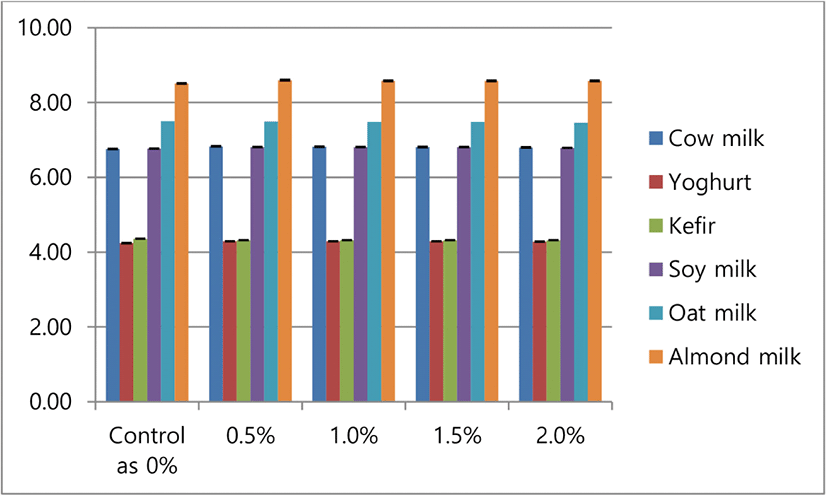
In pH, no statistically significant differences was observed in supplemented with vegetable oils to dairy or non-dairy products [13]. In this study, the pH grade exhibited a similar trend.
Fig. 3 showed the grade of organoleptic quality assessment of cow milk reviewed by the evaluator panel. Cow milk was supplemented with various concentrations (supplemented with 0.5% increments from 0% up to 2%) of ginger oil. When ginger oil was supplemented with cow milk from 0.5% to 2%, the grade of texture varied from 4.8 to 4.3, the grade of color varied from 3.3 to 1.3, the grade of flavor varied from 3.2 to 1.5, and the grade of overall acceptability varied from 3.7 to 1.3, which was generally lower than 5.0 of the control group (Fig. 3).
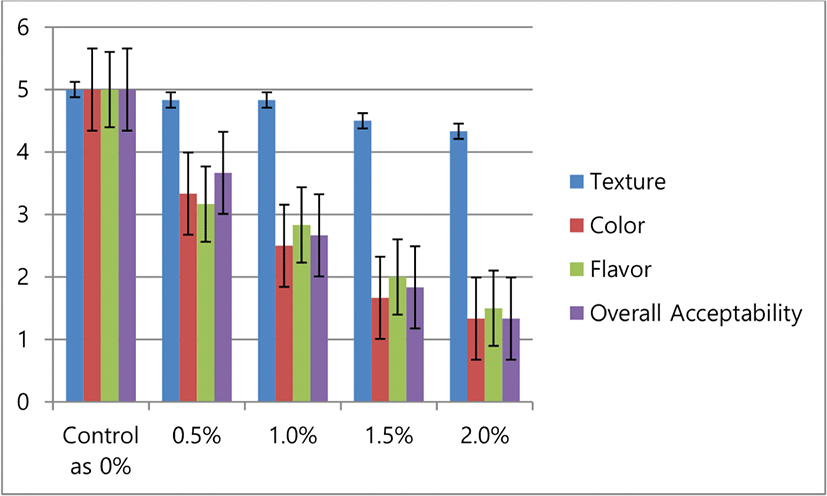
Grounded in the statistical analysis of the organoleptic quality assessment of cow milk obtained in this study, there was the statistically significant difference observed between the treated group and the control group in texture, color, flavor, and overall acceptability (p<0.05). On increasing the supplemented amount of ginger oil, the grade of organoleptic quality assessment of texture, color, flavor, and overall acceptability tended to decrease (Fig. 3). Hence, the cow milk supplemented with 0.5% of ginger oil showed the good results compared with control group in this study.
Fig. 4 showed the grade of organoleptic quality assessment of yoghurt reviewed by the evaluator panel. Yoghurt was supplemented with various concentrations (supplemented with 0.5% increments from 0% up to 2%) of ginger oil. When ginger oil was supplemented with yoghurt from 0.5% to 2%, the grade of texture varied from 4.8 to 4.7, the grade of color varied from 4.5 to 3.8, the grade of flavor varied from 3.7 to 1.8, and the grade of overall acceptability varied from 4.2 to 1.8, which was generally lower than 5.0 of the control group (Fig. 4). But, the grade of texture was very similar to that of the control group, and there was no statistically significant difference (p>0.05).
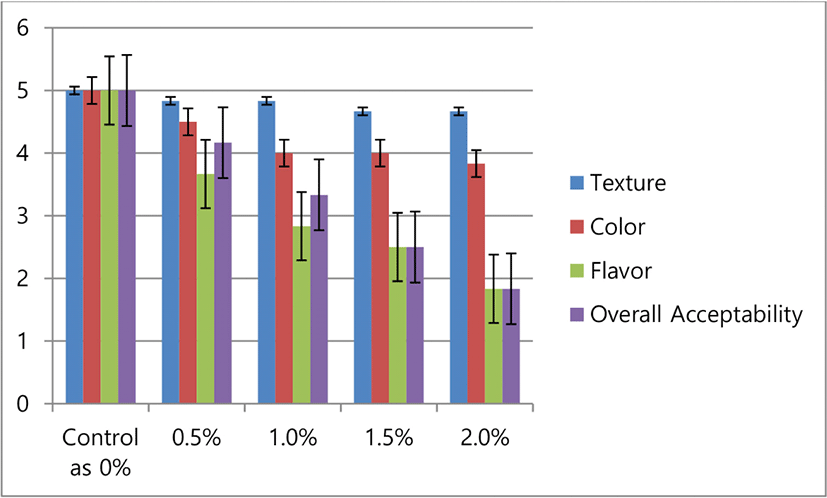
Grounded in the statistical analysis of the organoleptic quality assessment of yoghurt obtained in this study, there was the statistically significant difference observed between the treated group and the control group in color, flavor, and overall acceptability except texture (p<0.05). On increasing the supplemented amount of ginger oil, the grade of organoleptic quality assessment of color, flavor, and overall acceptability tended to decrease except texture (Fig. 4). Hence, the yoghurt supplemented with 0.5% of ginger oil showed the good results compared with control group in this study.
Fig. 5 showed the grade of organoleptic quality assessment of Kefir reviewed by the evaluator panel. Kefir was supplemented with various concentrations (supplemented with 0.5% increments from 0% up to 2%) of ginger oil. When ginger oil was supplemented with Kefir from 0.5% to 2%, the grade of texture varied from 4.8 to 4.3, the grade of color varied from 4.3 to 3.5, the grade of flavor varied from 4.8 to 3.0, and the grade of overall acceptability varied from 4.8 to 2.8, which was lower than 5 of the control group (Fig. 5). But, the grade of texture was very similar to that of the control group, and there was no statistically significant difference (p>0.05).
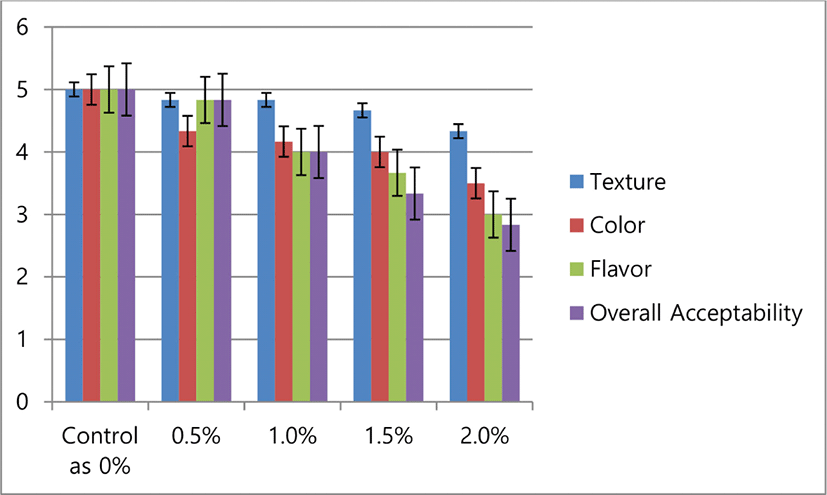
Grounded in the statistical analysis of the organoleptic quality assessment of Kefir obtained in this study, there was the statistically significant difference observed between the treated group and the control group in texture, color, flavor, and overall acceptability (p<0.05). On increasing the supplemented amount of ginger oil, the grade of organoleptic quality assessment of texture, color, flavor, and overall acceptability tended to decrease (Fig. 5). Hence, the Kefir supplemented with 0.5% of ginger oil showed the good results compared with control group in this study.
Fig. 6 showed the grade of organoleptic quality assessment of soy milk reviewed by the evaluator panel. Soy milk was supplemented with various concentrations (supplemented with 0.5% increments from 0% up to 2%) of ginger oil. When ginger oil was supplemented with soy milk from 0.5% to 2%, the grade of texture varied from 4.7 to 4.3, the grade of color varied from 4.2 to 2.7, the grade of flavor varied from 4.2 to 2.0, and the grade of overall acceptability varied from 3.8 to 2.0, which was lower than 5 of the control group (Fig. 6).
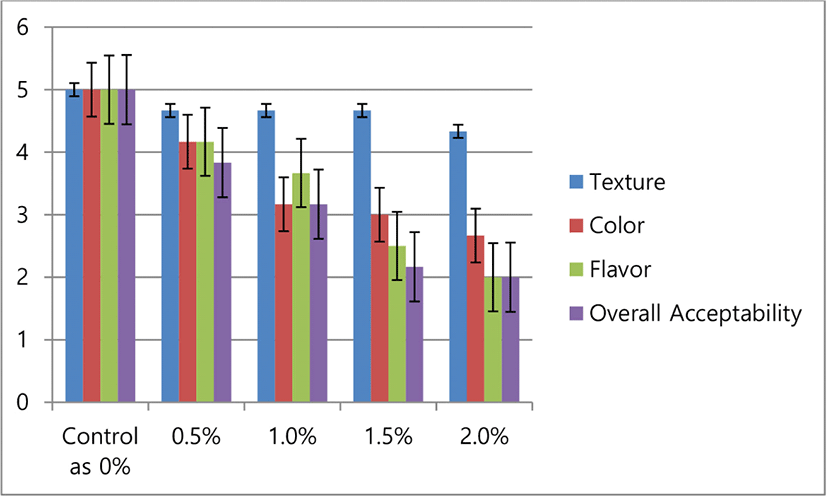
Grounded in the statistical analysis of the organoleptic quality assessment of soy milk obtained in this study, there was the statistically significant difference observed between the treated group and the control group in texture, color, flavor, and overall acceptability (p<0.05). On increasing the supplemented amount of ginger oil, the grade of organoleptic quality assessment of texture, color, flavor, and overall acceptability tended to decrease (Fig. 6). Hence, the soy milk supplemented with 0.5% of ginger oil showed the good results compared with control group in this study.
Fig. 7 showed the grade of organoleptic quality assessment of oat milk reviewed by the evaluator panel. Oat milk was supplemented with diverse concentrations (supplemented with 0.5% increments from 0% up to 2%) of ginger oil. When ginger oil was supplemented with oat milk from 0.5% to 2%, the grade of texture varied from 4.7 to 4.3, the grade of color varied from 4.2 to 2.2, the grade of flavor varied from 4.8 to 2.5, and the grade of overall acceptability varied from 4.5 to 2.2, which was lower than 5 of the control group (Fig. 7).
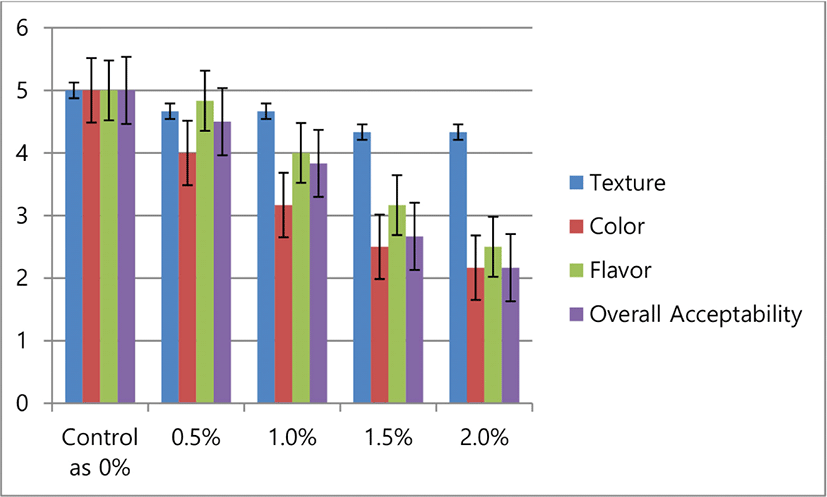
Grounded in the statistical estimation of the organoleptic quality assessment of oat milk obtained in this study, there was the statistically significant difference observed between the treated group and the control group in texture, color, flavor, and overall acceptability (p<0.05). On increasing the supplemented amount of ginger oil, the grade of organoleptic quality assessment of texture, color, flavor, and overall acceptability tended to decrease (Fig. 7). Hence, the oat milk supplemented with 0.5% of ginger oil showed the good results compared with control group in this study.
Fig. 8 showed the grade of organoleptic quality assessment of almond milk reviewed by the evaluator panel. Almond milk was supplemented with various concentrations (supplemented with 0.5% increments from 0% up to 2%) of ginger oil. When ginger r oil was supplemented with almond milk from 0.5% to 2%, the grade of texture varied from 4.7 to 4.3, the grade of color varied from 3.8 to 2.2, the grade of flavor varied from 4.5 to 2.0, and the grade of overall acceptability varied from 4.3 to 2.0, which was lower than 5 of the control group (Fig. 8).
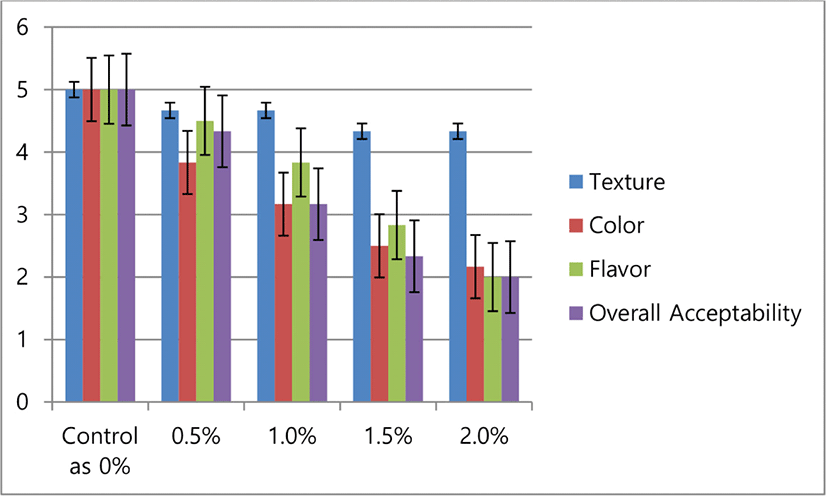
Grounded in the statistical estimation of the organoleptic quality assessment of cow milk obtained in this study, there was the statistically significant difference observed between the treated group and the control group in texture, color, flavor, and overall acceptability (p<0.05). On increasing the supplemented amount of ginger oil, the grade of organoleptic quality assessment of texture, color, flavor, and overall acceptability tended to decrease (Fig. 8). Hence, the almond milk supplemented with 0.5% of ginger oil showed the good results compared with control group in this study.
Also, Fig. 9 showed the color change processing in cow milk, yoghurt, Kefir, soy milk, oat milk, and almond milk supplemented with various concentrations of ginger oil. Cow milk, yoghurt, Kefir, soy milk, oat milk, and almond milk supplemented with various concentrations (supplemented with 0.5% increments from 0% up to 2%) of ginger oil were surveyed to change to a weak yellow color in this study (Fig. 9). Hence, the grade of color showed a tendency to decrease a lot in the organoleptic quality assessment of cow milk, yoghurt, Kefir, soy milk, oat milk, and almond milk to which ginger oil was supplemented (Fig. 3–8).
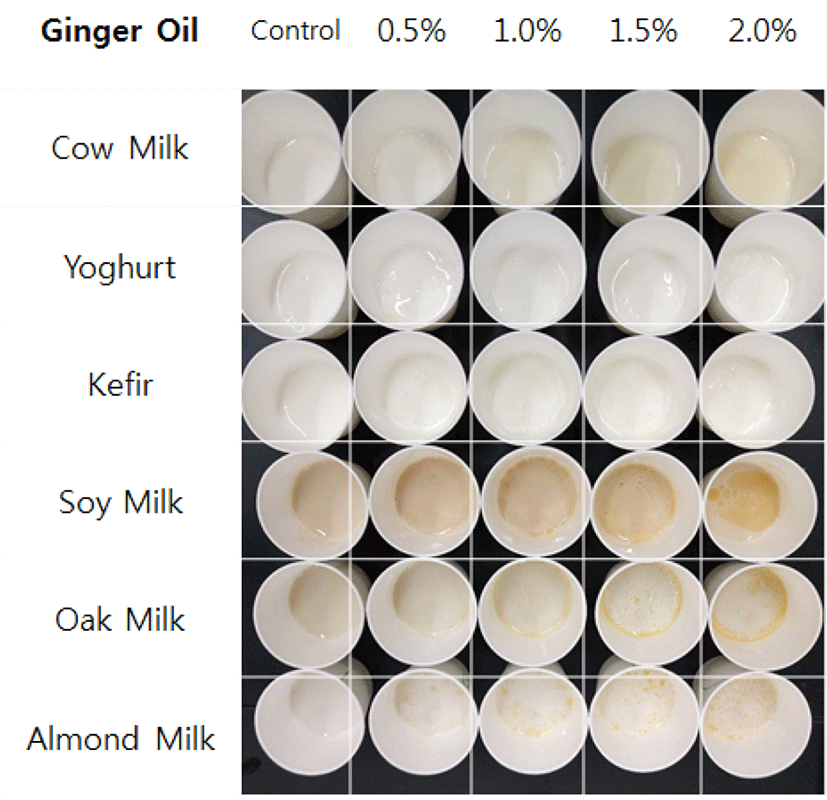
Ginger is known to show the potent antioxidant characteristics comparable to standard synthetic antioxidants such as butylated hydroxytoluene and butylated hydroxyanisole [14]. This means that ginger could mitigate or postpone the disease progressing associated with the oxidative stress [14]. Also ginger has been shown to alleviate the pain of arthritis by disrupting the inflammatory cascade and vanilloid nociceptors [15]. In addition, it had been demonstrated through in vitro, in vivo and epidemiological studies that ginger and its bioactive materials were efficient against various human cancers such as bile duct cancer, colorectal cancer, gastric cancer, liver cancer, pancreatic cancer, and so on [16]. These facts mean that ginger could be an excellent nutraceutical among spices, with anti-diabetic, anti-obesity, cardioprotective, and lipid-lowering effects [16,17]. Furthermore, ginger oil was rich in α-pinene and β-pinene, so it could show the best larval activity [18]. Also ginger oil had excellent antibacterial activity and could inhibit Bacillus cereus, Enterococcus faecalis, Staphylococcus aureus, and so on [18]. Therefore, it is true that the importance of research related to ginger and ginger-derived oil is gradually increasing.
In conclusion, the organoleptic quality assessment obtained in this study is summarized as follows. Especially, owing to the strong aroma and weak yellow-color of ginger oil, the overall grade showed a tendency to be very poor on increasing the supplementation concentration of ginger oil to cow milk, yoghurt, Kefir, soy milk, oat milk, and almond milk.
In addition, the various opinions of the evaluators who participated in this study are detailed below. When 1% or more of ginger oil was added, it was somewhat difficult to consume due to the strong pungent taste and aroma of ginger oil. The combination with milk and fermented milk was not good overall, which is thought to be because ginger oil has a strong unique flavor and oily feeling. Again, ginger oil inhibited the intrinsic flavor of milk in milk and fermented milk, and thus did not show consistency of taste. The sweet and sour taste of kefir and the unique flavor of kefir were found to have a personality with the added ginger flavor blending well. In kefir, the overall flavor was increased, however, as the amount added increased, the balance of taste/flavor was broken, resulting in poor results. Soymilk was better than milk, but the balance of taste was also not good, which is thought to be due to the strong flavor of ginger oil. Ginger flavor goes well with the unique flavor of oat milk, and the flavor is also good. Mixing of almond milk and ginger oil had good matching, but it was observed that the higher the concentration, the poorer the balance.
As the next step, it should be preceded by checking the concentration with little difference in grade from the control group in organoleptic quality assessment while subdividing the supplement concentration of ginger oil to less than 0.5%. And even at this concentration, studies to confirm the various bioactive activities that ginger oil can exhibit should be conducted.






